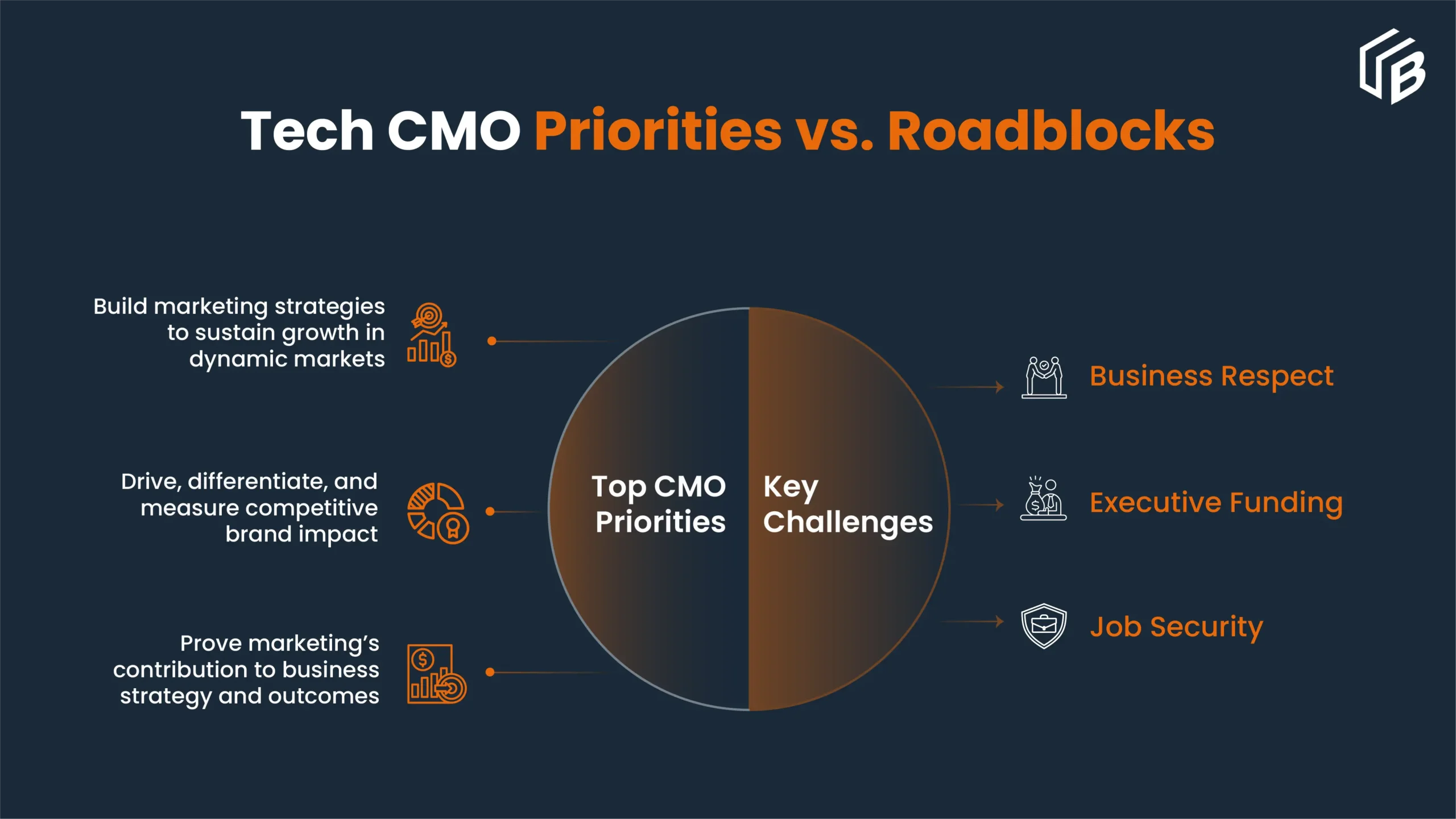
Buyers have altered their decision-making process. Now, the journeys are longer, more unpredictable, and often happen behind the scenes or we can call it the dark funnel. In this arena, relying on traditional marketing metrics simply doesn’t give us the full picture.
These numbers might be familiar, but they don’t show how your brand is performing in the market or how your marketing efforts are influencing buyer decisions. That is where modern marketing metrics help CMOs connect the dots between visibility, interest, and actual buyer behavior.
According to Gartner, today’s technology CMOs face a tough balancing act. While they focus on driving growth, building brand differentiation, and proving marketing’s impact, they still face challenges like earning business respect, securing executive funding, and maintaining job security.

Why Outdated Marketing Metrics Like MQLs and CTRs No Longer Work
For years, we have seen marketers have relied on metrics like impressions, click-through rates (CTRs), and marketing-qualified leads (MQLs) to measure success. While these numbers may look good on reports, they often fail to reflect what truly matters and that is how your marketing efforts drive meaningful engagement and contribute to revenue.
Today, where buying decisions are complex and involve multiple stakeholders, these surface-level metrics can be misleading.
Here’s a simple example:
Imagine your latest LinkedIn campaign shows a high CTR. On paper, that suggests your message is resonating. But when sales teams follow up with those leads, there’s little to no interest and so far, no real pipeline growth. This happens often because a click doesn’t always indicate intent, and an MQL doesn’t guarantee a sales opportunity.
Outdated marketing metrics may give you activity numbers, but they don’t tell the full story of how your marketing is influencing real business outcomes. Vanity metrics no longer suffice, and it is high time to shift to metrics reflecting buyer intent, engagement quality, and revenue generation.
If you’re wondering which marketing metrics to replace MQLs with, don’t worry, we’ll cover that in the next section.
What Modern Marketing Metrics Matter Most in B2B Today
Today, it’s less about generating activity and more about tracking meaningful influence factors like how visible your brand is, how buyers engage with it, and how your efforts contribute to business outcomes.
That’s where modern marketing metrics come in. They help CMOs understand market presence, buyer engagement, and overall impact.
Here are some of the key metrics every B2B CMO should focus on:
1. Share of Voice in Marketing
Share of Voice (SOV) measures how much your brand is mentioned or visible compared to your competitors across channels like media, advertising, or online conversations. In short, it reflects your overall presence in the market.
A higher Share of Voice often signals stronger brand awareness and, over time, can help drive greater market share.
2. Share of Search vs. Share of Voice
Share of Search tracks how often buyers actively search for your brand online compared to others in your category. It gives you a clear indication of brand interest and buyer intent. It is essential in B2B, where the research process is long and deliberate.
3. Brand Recall Metrics in B2B Marketing
As we all know, it’s not enough to be noticed, your brand should be remembered. Brand recall tracks how well your brand stays with potential buyers after the first touchpoint.
4. Engagement Metrics in B2B
Meaningful engagement is not just about the number of clicks you are getting. It shows how buyers interact with your content and campaigns across channels.
5. Buying Stage Engagement
Different stages of the buyer journey require different types of engagement. Tracking buyer’s engagement behavior helps you understand where your marketing has the most influence and where there’s room to improve.
The Importance of Share of Voice and Share of Search and How to Measure Them
We all agree that the B2B buyer journey is complex and decisions often happen behind the scenes and dark funnel activity is common. In such scenarios, relying on lead counts or CTRs alone can leave critical gaps in understanding your brand’s true impact.
That’s where modern marketing metrics like Share of Voice and Share of Search become essential.
Now you might be wondering what is the difference between share of voice vs. share of search. Well:

1. How to Measure Share of Voice in B2B
To track Share of Voice, you can measure:
- Paid Media SOV: Your share of total ad impressions in your industry.
- Organic SOV: Your share of content rankings and social media mentions compared to competitors.
- Earned Media SOV: Your brand’s share of media coverage, press mentions, or third-party articles.
2. Practical Tools to Measure Share of Voice:
- SEMrush, Ahrefs: Track keyword rankings and content visibility.
- Meltwater, Brandwatch: Monitor brand mentions, competitor coverage, and industry news.
- Social Listening Tools: Measure share of conversation across social platforms.
3. How to Measure Share of Search in B2B
To track Share of Search, monitor:
- Branded Search Volume: How often buyers search for your company name compared to competitors.
- Trend Over Time: Is search interest in your brand growing relative to others?
4. Practical Tools to Measure Share of Search:
- Google Trends: Compare branded search interest across time and competitors.
- Google Search Console: Monitor branded search traffic to your website.
- SEMrush: Analyze search volumes for branded keywords.
How to Measure Engagement Metrics Across the B2B Buying Journey
In B2B marketing, relying on the old idea of a neat, linear funnel simply doesn’t work anymore. Buyers don’t move step by step from awareness to decision. Instead, their journey is unpredictable in ways that are filled with research, peer conversations, content interactions, and often, invisible activity within the dark funnel.
That’s why understanding how to measure engagement across the buying journey is so crucial for B2B CMOs today.
1. Modern Engagement Metrics for B2B CMOs
Meaningful engagement goes far beyond website clicks or form fills. The most effective B2B marketers look at a range of signals to understand how buyers interact with their brand at different stages of the journey.
Here are some key engagement metrics in B2B to focus on:
- Content consumption across formats (blogs, videos, white papers)
- Time spent on high-intent pages
- Webinar or event participation
- Buying group engagement, that is, tracking interactions across multiple stakeholders
- Social engagement, like comments, shares, and discussions, not just impressions
- Intent data signals from third-party platforms
2. Tracking Multi-Touch, Dark Funnel, and Buying Group Engagement
Modern B2B buying rarely involves just one person or one touchpoint. To truly understand buyer engagement, you need to track:
- Multi-Touch Engagement:
In most B2B journeys, it’s not a single campaign or touchpoint that drives a decision. It’s a combination of efforts working together. Tracking multi-touch engagement helps you understand how different marketing activities like emails, paid ads, content, and events collectively influence buyers throughout the process.
- Dark Funnel Activity:
Many buyer interactions happen outside your direct tracking on social media, through peer networks, or in communities. While not always measurable in detail, intent data providers and social listening tools can help uncover some of this hidden activity.
- Buying Group Engagement:
In B2B, purchase decisions often involve multiple stakeholders. Tracking how individuals within the same account engage across channels gives a clearer view of true buying intent.
Tracking engagement across the entire B2B buying journey helps CMOs understand how their marketing efforts drive influence, even when the buyer’s path isn’t linear.
In the next section, we’ll explore why tracking brand recall metrics is just as important for long-term growth.
Brand Recall Metrics in B2B Marketing
In B2B markets, remembering brands is essential when buying decisions are made. That’s where brand recall metrics play a key role.
There’s a direct link between strong brand awareness and pipeline performance. When your brand is consistently present and memorable, you’re more likely to be included in buyer consideration, even before your sales team gets involved.
How to Track Brand Recall Effectively
Brand recall may sound difficult to measure, but with the right approach, it’s achievable. Here are a few reliable ways to track it:
- Surveys and Brand Awareness Studies:
Ask your target audience if they recognize your brand, both unprompted and prompted.
- Branded Search Trends:
Monitor how often buyers search specifically for your brand name or branded keywords using tools like Google Trends.
- Direct Traffic and Referral Patterns:
Track increases in direct website visits or referrals from trusted industry sources. These can signal higher brand familiarity.
- Social Listening:
Measure how often your brand is mentioned in industry conversations, even when you’re not part of the discussion directly.
Real B2B Example:
Cadence Design Systems
Cadence, a leading EDA software provider, invested heavily in a thought leadership and SEO-driven content marketing strategy. Over the course of a year, their campaign led to a 934% increase in total keyword rankings, significantly boosting brand visibility. As a result, they saw record growth in subscribers, free trial requests, and user signups. These are all the clear indicators of increased brand recall translating into tangible business outcomes.
Marketing KPIs Every CMO Should Track
CMOs must go beyond individual data points to demonstrate the real value of marketing. Rather, concentrate on marketing KPIs that reflect revenue impacts and business performance. These are the most critical metrics that every CMO must monitor that illustrate actual value:
- Marketing-Sourced Pipeline:
Marketing-sourced pipelines refer to the amount of sales pipeline directly generated by marketing efforts.
- Share of Voice and Brand Recall:
Together, these reflect your influence and visibility in the market.
- Buying Group Engagement:
Buying group engagement tracks interactions across all stakeholders involved in a deal, which are critical for complex B2B sales.
- Multi-Touch Attribution Performance:
Shows how different marketing activities work together to drive conversions.
- Brand Search Trends:
Brand search trends reflect how often people actively search for your brand online and rising search volumes are often one of the earliest signs of growing market demand and brand reputation.
These are strategic modern metrics for marketing performance that connect directly to revenue growth and business success.
Conclusion: Future-Proofing Your Modern Marketing Metrics
The truth is obvious: old-time traditional metrics such as impressions, CTRs, or even mere lead numbers do not clearly highlight the entire picture anymore.
To succeed in 2025 and beyond, B2B CMOs must shift to modern marketing metrics that reflect influence, engagement, and revenue contribution. Measurements such as share of voice, share of search, engagement through the buying process, brand recall, and revenue-aligned KPIs provide greater visibility into the effectiveness of marketing.
More to the point, these metrics can future-proof your strategy, so your marketing not only gets attention but also creates actual, measurable business outcomes. That’s what sets successful CMOs apart.
Our blog
Latest blog posts
Tool and strategies modern teams need to help their companies grow.

In this article, we’ll explore how AI-driven content, AI lead scoring, and AI-drive...

Marketers often confuse drips vs nurtures, but each plays a distinct role in B2B emai...

This article explores the key differences between enterprise sales vs SMB sales, high...







